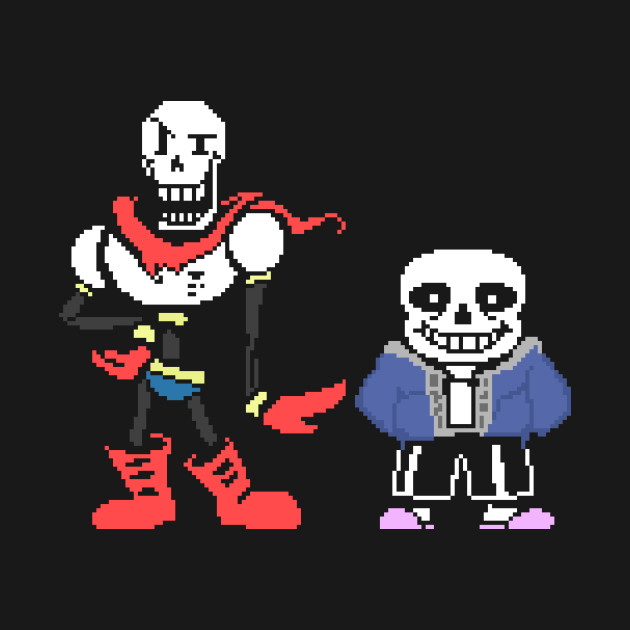Font Skeleton (5e Race)

|
|---|
Font Skeleton[edit]
Physical Description[edit]

|
|---|
| Sans and Papyrus, two font skeleton brothers. |
Font skeletons look, for the most part, like ordinary skeletons. The only main differences are their glowing eyes and their ability to walk and talk (well, some other skeletons do that as well). Font skeletons also don't speak, their jaws simply move while a speech bubble forms above them with the words they want to say. One other trait of font skeletons is the fact their faces are stiff bone, so their mouths are stuck with permanent grins.
History[edit]
Font skeletons come from a group of ancient monsters, trapped far, far underground. These monsters lived there for generations, until an angel child came down from the surface. In some timelines, the angel liberated them from the underground, while in other timelines, the angel destroyed them all. The unusual part of it is that some font skeletons are actually able to remember some of these alternate timelines, whichever one they exist in. In the timelines where the angel destroyed them all, it is told that one font skeleton mounted a powerful resistance against the angel, and was almost able to stop it. But he, like the others, eventually fell. In the timelines where the angel liberated these monsters, more and more font skeletons appeared, following their hearts' desires; whether it is to become a world-renowned scientist, or to sit on their couch and eat chips all day, font skeletons are just as diverse in their actions as the surface races are.
Society[edit]
Most font skeletons never meet each other, so the definition of "society" is rather loose. However, font skeletons usually get along quite well with others and tend to fit into communities. Sans and Papyrus (two font skeleton brothers) live in the monster town of Snowdin, where they work as sentries. In the timelines where the font skeletons made it to the surface, they, like most of the other monsters, live in harmony with the other surface races.
Font Skeleton Names[edit]
As a font skeleton, you are always either named after the font you speak, or the font you speak is named after you.
Common Names: Courier, Times, Impact, Lucida, Goudy, Arial, Bookman, Serif, Roman, Robert Turney, Sans, Papyrus
Font Skeleton Traits[edit]
| Mysterious monsters that speak using their own unique typefaces. Ability Score Increase. Your Intelligence score increases by 2 and your Charisma score increases by 1. Age. Font skeletons mature as fast as humans but do not age afterwards unless they have biological children. Once they have a child, they age at a rate where they die at the time their first child matures. Alignment. Font skeletons can be any alignment but tend to lean towards chaotic. There have been no records of evil font skeletons, but that doesn't mean they don't exist. Size. Font skeletons vary extremely widely in size and build, with their heights ranging from less than five feet to around six feet high. Your size is Medium. Speed. Your base walking speed is 30 feet. |
| Font Speakers. Font skeletons have a special ability in which causes them to not speak. Instead, a floating bubble appears with what you want to say written in Common script in it. You can still cast spells this way, and if you have learned another language script, you may choose to display it in that script instead. If your font uses a character-replacement script (one where each character is replaced with a symbol, e.g. Wingdings), then any creatures who do not know the script cannot understand your speech (you may choose to write messages in an ordinary script); for other creatures to learn the script, they must spend 1d6 minus their Wisdom modifier hour (minimum of 30 minutes) studying the script. |
| SAVE Sensitivity. Being in tune time and space has given you an enhanced view of reality. When you roll a 1 on an attack roll, ability check, or saving throw, you can reroll the die and must use the new roll. |
Bone Magic. As a font skeleton, you can summon bones using your innate magic and use them to attack your enemies. You automatically satisfy any material requirements in spells that require bones, and you can use an attack to summon bones to do one of the following:
When you use this trait, roll 1d4; if you roll a 4, some of the bones in the attack glow light blue, and the targeted creature takes half damage if they failed the saving throw, or full damage if they succeeded on it. |
| Gaster Blaster. Summons a phantasmic skull that blasts a ray of energy at one target you can see within 60 feet. The creature must make a Dexterity saving throw. The DC for the saving throw equals 8 + your Intelligence modifier + your proficiency bonus or take 1d8 force damage. The damage increases to 2d8 at 5th level, 3d8 at 11th level, and 4d8 at 17th level. |
| Languages. You can "speak," read, and write Common and one other of your choice. |
Random Height and Weight[edit]
| Base Height |
Height Modifier* |
Base Weight |
Weight Modifier** |
|---|---|---|---|
| 4′ 0'' | +4d8 | 110 lb. | × (1d4) lb. |
|
*Height = base height + height modifier | |||
Back to Main Page → 5e Homebrew → Races

